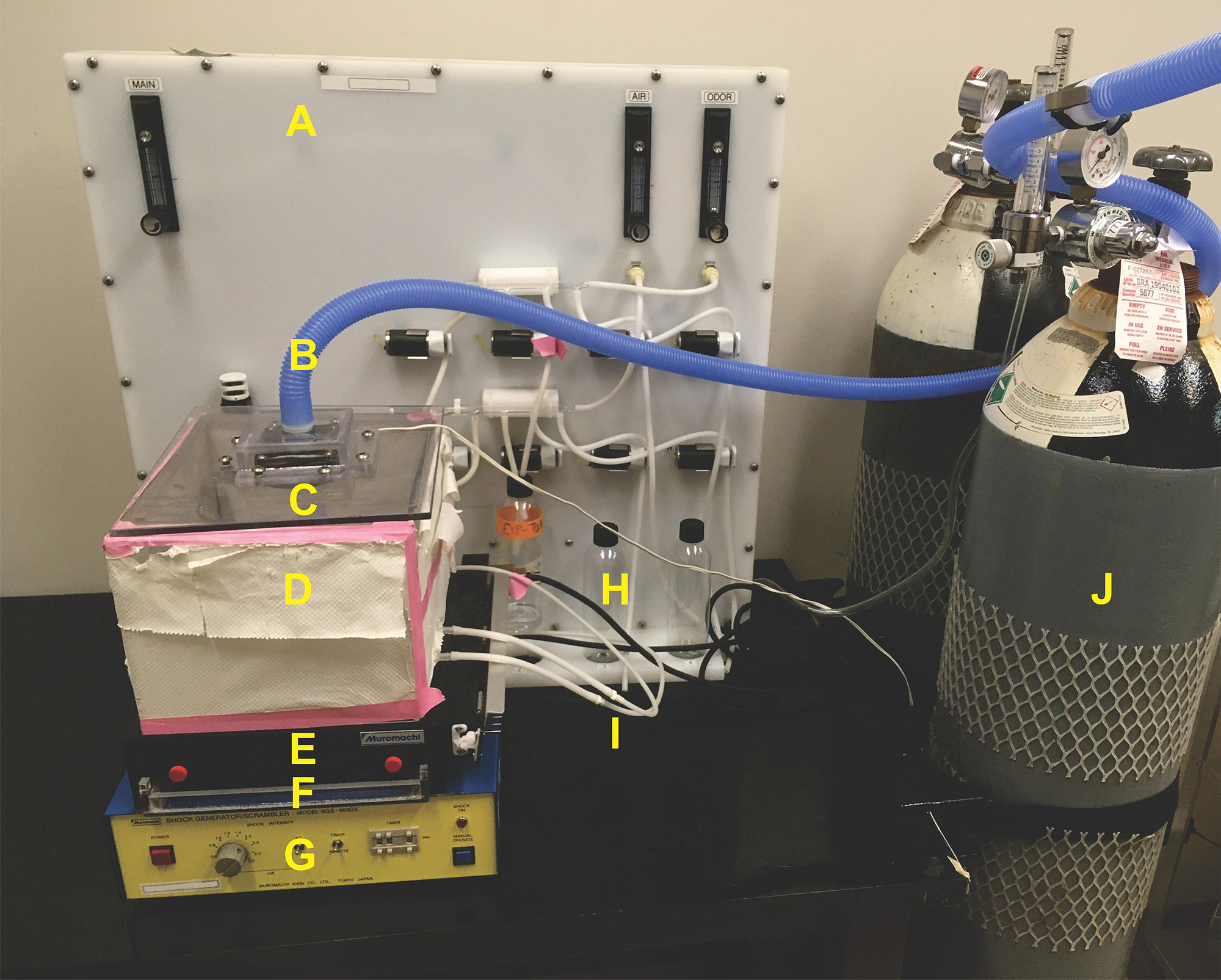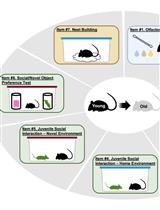- EN - English
- CN - 中文
Shared Pheromonal Communication of Specific Fear Between Adult Sprague Dawley Rats
成年SD大鼠特定恐惧的信息素通讯
发布: 2020年03月20日第10卷第6期 DOI: 10.21769/BioProtoc.3564 浏览次数: 3317
评审: Karen N KrukowskiLinlin SunAnonymous reviewer(s)
Abstract
Rats are highly social animals, and mainly communicate with one another in two ways: through ultrasonic vocalizations and pheromones. Most research on pheromones has been dedicated those regarding sexual behavior, but more recently pheromones which signal danger to conspecifics have been identified in rodents. In fact, rats are capable of communicating information regarding a specific fear to a companion with which they share a cage. If a rat is trained to associate a previously neutral odor with a foot shock and then pair housed with another rat, the companion will also display a fear response specific to the trained odor, despite never being shocked itself. This communication relies on pheromones; presenting soiled bedding from a shocked rat to an individually housed naïve rat produces the same fear response in the naïve rat. The current protocol describes how to produce this phenomenon in adult Sprague Dawley rats. It is simple and easily reproduced, requires minimal equipment, and may be completed within one week.
Keywords: Alarm Pheromone (报警信息素)Background
Like humans, rats are considered a social species; they tend to thrive with conspecifics rather than in isolation. Generally, rats can relay information through ultrasonic vocalizations and pheromones. Given their highly developed olfactory systems, a wide array of information may be conveyed through the sense of smell. Releasing and receiving pheromonal signals play critical roles in both neurobiological and ethological aspects of rodent behaviour. These include but are not limited to the selection of mating partners (Kumar et al., 2014), spreading alarm signals (Kiyokawa et al., 2013), novel food acquisition (Posadas-Andrews and Roper, 1983), territory marking (Brain et al., 2009), demonstrating social status (Krames et al., 1969), and maternal interaction (Bind et al., 2013). Pheromonal signaling can actually interfere with several biological functions in a laboratory setting; the presence of unfamiliar males can prevent pregnancy (Bruce, 1959), female estrous cycles may become prolonged when exposed to urine from a lactating female (Hoover and Drickamer, 1979), and male urine can cause acceleration of puberty in females (Vandenbergh, 1975). It has been known for some time that certain pheromones can carry information regarding sexual behaviours (Hayashi and Kimura, 1974; Gawienowski et al., 1975), but more recently it has been conclusively shown that mammals can also communicate information about stress via alarm pheromones (Inagaki et al., 2014; Kiyokawa, 2017).
Social fear learning is a growing field in neuroscience and many models have been used to attempt to study how it works. The subtle differences in approach give clues as to how rodents are actually able to communicate with one another. Knapska et al. (2006) exposed rats to shock in a novel context then allowed their cagemate, the “observer”, to interact with this “demonstrator” rat. They found that observer rats housed with a demonstrator that had been fear conditioned spent more time interacting with the demonstrator and an enhanced acoustic startle response following this interaction, suggesting a transfer of emotional states between the two animals. Bruchey et al. (2010) developed a fear conditioning by proxy paradigm whereby a naïve rat watches its cagemate respond to a previously fear conditioned auditory stimulus. When the trained cagemate freezes in response to the tones, this causes the naïve rat to develop a fear reaction to subsequent presentations of the conditioned stimulus. Although the naïve rat had never received a shock, witnessing fearful behavior of its cagemate in response to the tone was enough to cause a conditioned response (albeit weaker than the classically conditioned fear) in some of the rats. The degree of success in fear conditioning by proxy was correlated with the duration of social interaction during the procedure. Again, it is clear that interaction with a stressed conspecific is sufficient to induce some behavioural change in a rat’s emotional response.
Since rats rely so heavily on their sense of smell, it is likely that this communication occurs through an olfactory mode, likely via pheromones, as opposed to ultrasonic vocalizations. Debiec and Sullivan (2014) found that a stressed mother’s scent delivered through an olfactometer paired with a novel odor caused avoidance to that odor in pups. A series of experiments from the Mori group has identified a rat alarm pheromone that causes stress-induced hyperthermia in recipient rats, as well as increased defensive and risk assessment behaviours combined with a decrease in exploratory and grooming behavior (Kikusui et al., 2001; Kiyokawa et al., 2006). This rat alarm pheromone has been isolated and two of its components, 4-methylpentanal and hexanal, produce the same behavioural effects as the pheromone itself (Inagaki et al., 2014). Two things are clear from the previous research: 1) information can be conveyed regarding emotional responses between conspecific rats and 2) interaction between a naïve rat and either a conditioned rat or a pheromonal component of its odor is important for this communication.
The current protocol describes the use of same sex 8-10-week old Sprague Dawley rat pairs as odor + shock (O+/S+) and companion (O+/Comp) conditions in a paradigm by which a conditioned fear of a specific odor is communicated from the O+/S+ rat to its companion. This paradigm produces a socially conditioned fear in a rat whose cagemate has been classically conditioned to associate an odor with a shock. Unshocked O+/SB rats are also able to acquire this fear in the absence of a cage mate by being exposed to the soiled bedding of an O+/S+ rat along with the conditioned odor. In fact, pairing previously identified alarm pheromone components with the conditioned odor also produces this phenomenon in unshocked O+/Ph rats. Together, these experiments provide strong support to the notion that rats are able to communicate a specific fear through pheromones. As opposed to other methodologies, the current protocol may reflect actual communication through pheromones rather than just a transfer of emotional states, as the socially acquired fear is specific to the trained odor and is not generalized to a different stimulus if presented after the interaction. The protocol described below does not require expensive equipment or materials, and can be completed within one week.
Materials and Reagents
- Gloves
- Labcoat
- Hairnet
- Face mask
- Rats
- α-Terpinene (Millipore Sigma, Sigma-Aldrich, catalog number: 86473 ), store in flammable cabinet
- Octanol (Millipore Sigma, Sigma-Aldrich, catalog number: 297887 ), store in flammable cabinet
- Mineral Oil (Millipore Sigma, Sigma-Aldrich, catalog number: 330760 ), store in flammable cabinet
- 4-methylpentanal (Santa Cruz Biotechnology, catalog number: sc-483809 ), store in flammable cabinet
- Hexanal (Santa Cruz Biotechnology, catalog number: sc-252885 ), store in flammable cabinet
- 100% ethanol (Commercial Alcohols, catalog number: P016EAAN ), store in flammable cabinet
- Purified water
- Terpinene (6.63%) (see Recipes)
- Octanol (2.67%) (see Recipes)
- 4-methylpentanal (1.6 x 10-6 M) and hexanal (8.7 x 10-6 M) binary mixture (see Recipes)
- Ethanol (70%) (see Recipes)
Equipment
- Shock generator with grid and removable plexiglass tray (Muromachi, Kikai, model: SGS-003DX )
- Plexiglass box without bottom (Custom made)
- Clear lid for plexiglass box (Custom made)
- Fan-attached lid for plexiglass box (Custom made)
Note: The fan blows odors out of box through evacuation tubing which is connected to ventilation system in the ceiling. This allows for minimum permeation of odors into the room. - Evacuation tubing
- Odor delivery system (Custom made)
- Odor delivery bottles (Polyvinyl carbonate bottles with 2 holes in lid for c-flex tubing)
- Odor delivery c-flex tubing
- Medical air tank (95% O2 5% CO2)
Note: See Figure 1 for a labeled image of the experimental setup. - Air exchanger
- Timer
- Stopwatch
- Webcam and tripod
- Laptop
- Home cages

Figure 1. Labeled photograph of the custom-made experimental setup. A. Odor delivery system; B. Evacuation tubing; C. Fan-attached lid; D. Plexiglass box without bottom; E. Shock grid; F. Removable plexiglass tray; G. Shock generator; H. Odor delivery bottles; I. Odor delivery tubing (white); J. Medical air tank.
Procedure
文章信息
版权信息
© 2020 The Authors; exclusive licensee Bio-protocol LLC.
如何引用
Carew, S. J. and Ghosh, A. (2020). Shared Pheromonal Communication of Specific Fear Between Adult Sprague Dawley Rats. Bio-protocol 10(6): e3564. DOI: 10.21769/BioProtoc.3564.
分类
神经科学 > 行为神经科学 > 实验动物模型
神经科学 > 细胞机理 > 胞内信号传导
生物化学 > 其它化合物 > 离子
您对这篇实验方法有问题吗?
在此处发布您的问题,我们将邀请本文作者来回答。同时,我们会将您的问题发布到Bio-protocol Exchange,以便寻求社区成员的帮助。
Share
Bluesky
X
Copy link














